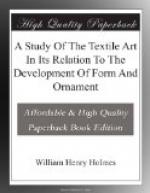We may distinguish two broad classes of constructive phenomena made use of in the expression of relieved enrichment. As indicated above, these are, first, essential or actual constructive features and, second, extra or superconstructive features.
First, it is found that in the practice of primitive textile art a variety of methods of combination or bindings of the parts have been evolved and utilized, and we observe that each of these—no matter what the material or what the size and character of the filamental elements—gives rise to distinct classes of surface effects. Thus it appears that peoples who happen to discover and use like combinations produce kindred decorative results, while those employing unlike constructions achieve distinct classes of surface embellishment. These constructive peculiarities have a pretty decided effect upon the style of ornament, relieved or colored, and must be carefully considered in the treatment of design; but it is found that each type of combination has a greatly varied capacity of expression, tending to obliterate sharp lines of demarkation between the groups of results. It sometimes even happens that in distinct types of weaving almost identical surface effects are produced.
It will not be necessary in this connection to present a full series of the fundamental bindings or orders of combination, as a few will suffice to illustrate the principles involved and to make clear the bearing of this class of phenomena upon decoration. I choose, first, a number of examples from the simplest type of weaving, that in which the web and the woof are merely interlaced, the filaments crossing at right angles or nearly so. In Fig. 291 we have the result exhibited in a plain open or reticulated fabric constructed from ordinary untwisted fillets, such as are employed in our splint and cane products. Fig. 292 illustrates the surface produced by crowding the horizontal series of the same fabric close together, so that the vertical series is entirely hidden. The surface here exhibits a succession of vertical ribs, an effect totally distinct from that seen in the preceding example. The third variety (Fig. 293) differs but slightly from the first. The fillets are wider and are set close together without crowding, giving the surface a checkered appearance.
[Illustration: Fig. 291. Surface relief in simplest form of intersection.]
[Illustration: Fig. 292. Surface relief produced by horizontal series crowded together.]
[Illustration: Fig. 293. Surface relief produced by wide fillets set close together.]
The second variety of surface effect is that most frequently seen in the basketry of our western tribes, as it results from the great degree of compactness necessary in vessels intended to contain liquids, semiliquid foods, or pulverized substances. The general surface effect given by closely woven work is illustrated in Fig. 294, which represents a large wicker carrying basket obtained from the Moki Indians. In this instance the ridges, due to a heavy series of radiating warp filaments, are seen in a vertical position.




